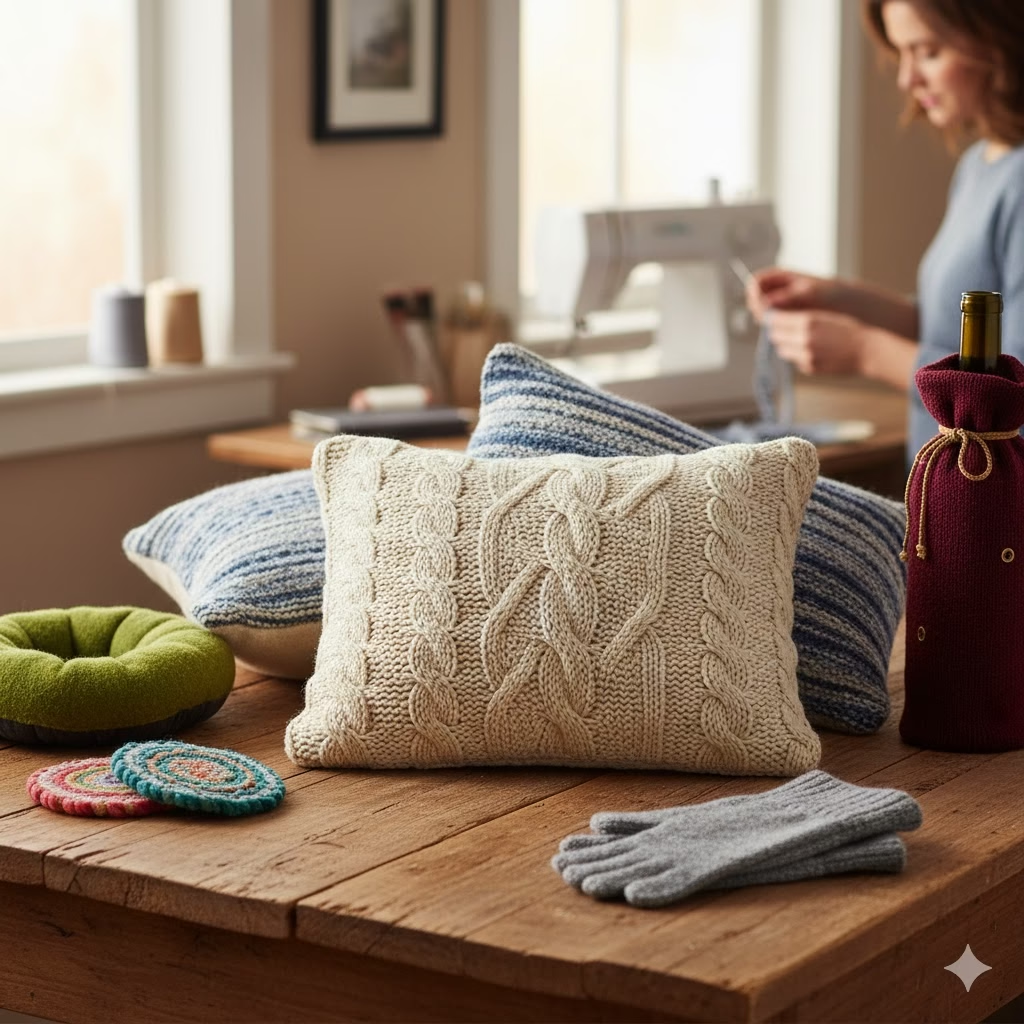
Hey there, fellow home enthusiasts! Like many of you, we are always searching for ways to make a home both beautiful and sustainable. After countless hours scrolling through design feeds and dreaming up kitchen makeovers, we found a secret that’s too good not to share: the enduring appeal of Reclaimed Wood. Join us as we explore how to bring character, history, and a touch of eco-chic into your most beloved space with this stunning material.
Embracing Reclaimed Wood: The New Luxury Begins Here
A beautifully styled kitchen featuring a prominent reclaimed wood island or worktop, perhaps with natural light streaming in, showcasing its unique grain and texture.
It used to be that luxury meant pristine, untouched, and brand new. We aspired to gleaming granite, flawless marble, or factory-perfect laminates. However, times, and tastes, are changing fast. A quiet revolution is happening in kitchen design. It’s led by a material that carries stories, whispers of history, and boasts a unique character no new product can ever replicate: reclaimed wood.
Forget what you thought about opulence. True luxury today is about authenticity, sustainability, and owning something unique. That is precisely what a reclaimed wood worktop delivers.
Why Reclaimed Wood? Beyond the Hype
The allure of reclaimed wood is more than just a trend. It’s a move toward conscious and meaningful design. When you choose a worktop made from reclaimed wood, you aren’t just buying a surface. You are investing in a piece of history, an heirloom for your home that tells a real tale.
1. Unmatched Character and Aesthetic Appeal
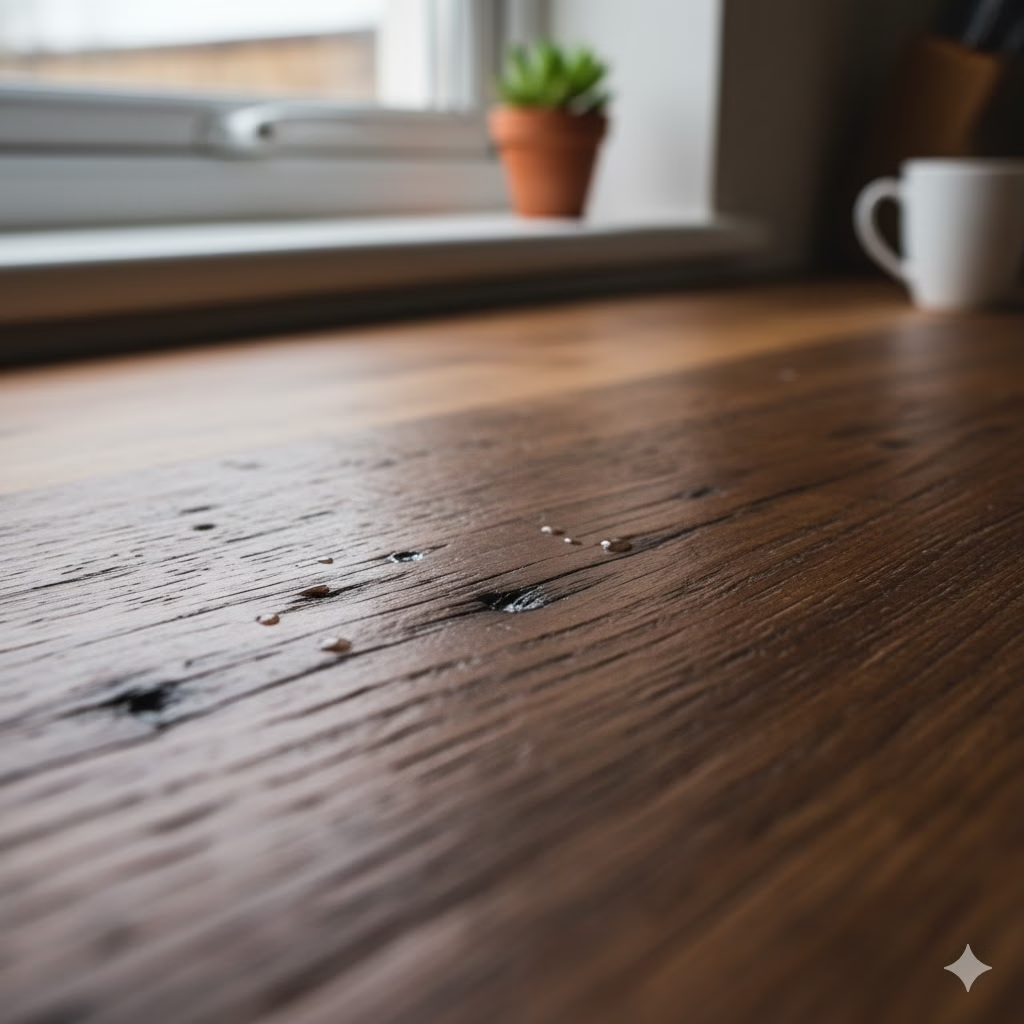
Imagine wood that has weathered decades, or even centuries, as part of an old barn, a forgotten factory, or a dismantled warehouse. This wood has seen seasons change and felt the hands of countless people. It has developed a unique finish that you cannot make artificially. Knots, nail holes, saw marks, grain variations, and natural distressing—these are not flaws. They are badges of honour.
Examples of Character-Rich Reclaimed Wood:
- Barnwood Oak: Often has a deep hue and incredible texture. It shows circular saw marks and natural blemishes.
- Factory Maple: Known for its hardiness and lighter tones. It often bears subtle marks from industrial use.
- Old Growth Douglas Fir: Can display stunning, tight grain patterns and a beautiful reddish-brown colour. It often comes from large timbers.
These elements create warmth and depth. They instantly elevate a kitchen and add a focal point that is both rustic and refined. This is the kind of feature that makes people pause, look closer, and ask, “Where did you get that?”
2. A Champion for Sustainability
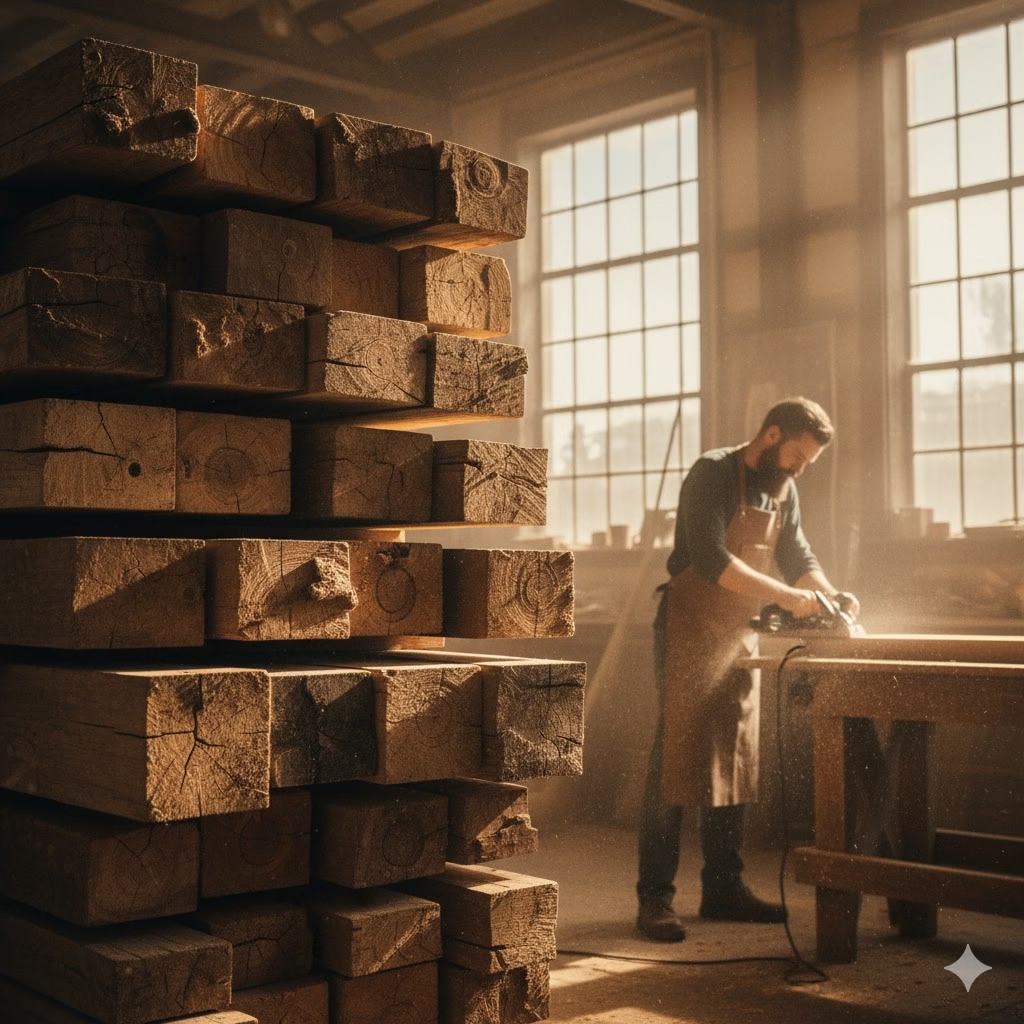
Environmental impact is a critical concern today. Choosing reclaimed wood is one of the most eco-friendly decisions you can make for your kitchen.
Reclaimed wood helps the planet by:
- Reducing Landfill Waste: These beautiful, aged timbers are given a second life instead of ending up in a dump.
- Conserving New Resources: Using reclaimed wood reduces the need for newly harvested timber. This helps preserve forests and their vital ecosystems.
- Lowering the Carbon Footprint: The energy needed to process reclaimed wood is far less than the energy required for harvesting, milling, and transporting new lumber.
It’s a simple win-win for your home and for the planet.
3. Inherent Durability and Stability
Do not let the “old” in reclaimed make you think it is weak. Wood that is reclaimed has often endured tough conditions for many decades. This long exposure to various climates causes the wood to fully season. This means it has stabilized, shrunk, and expanded as much as it ever will. Because of this, reclaimed wood is often more stable. It is less likely to warp and crack than newly cut timber.
How to Do It: Bringing Reclaimed Wood Luxury into Your Kitchen
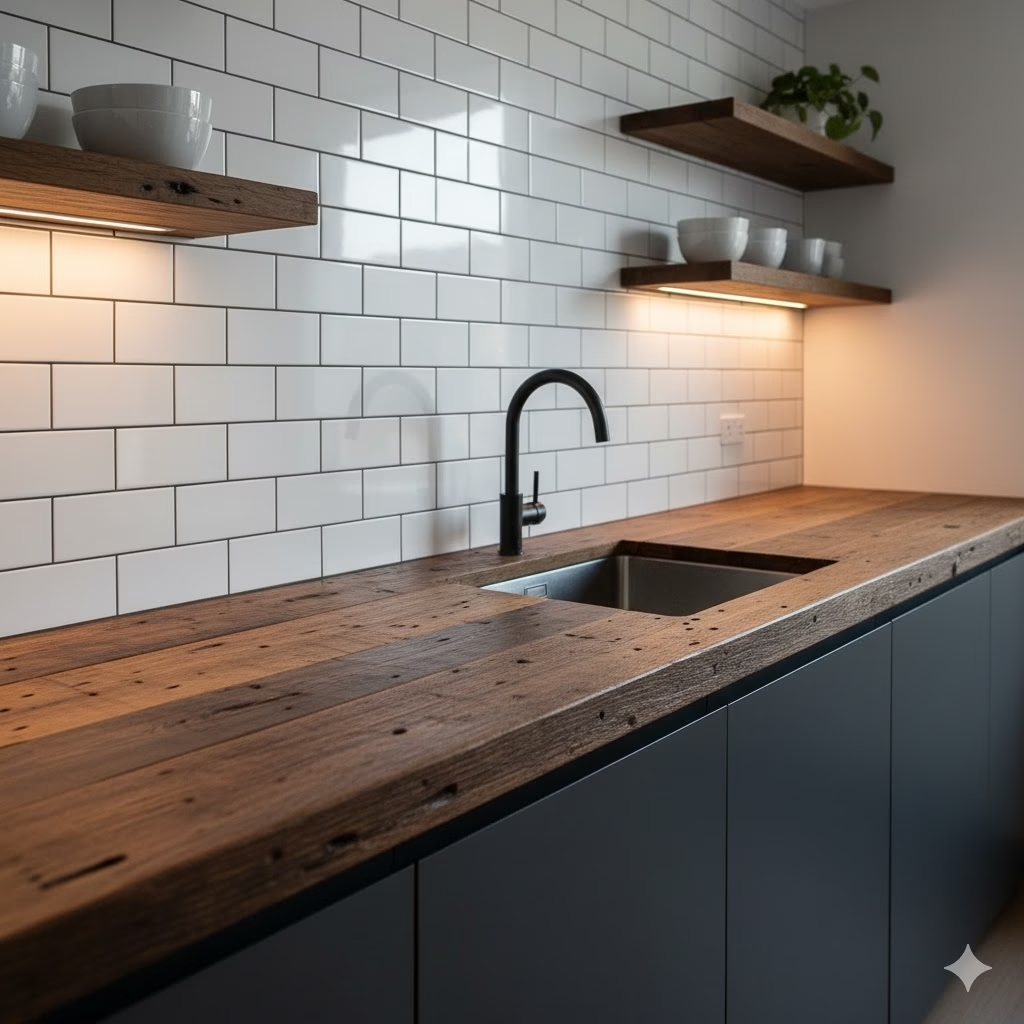
Ready to embrace the character of reclaimed wood? Here is your simple guide to making it happen.
Step 1: Sourcing Your Reclaimed Wood
This is perhaps the most exciting part! Finding the right supplier is very important.
Places to Find Quality Reclaimed Wood:
- Dedicated Reclaimed Wood Dealers: These specialists have networks for salvaging wood from old buildings. They offer a wide variety of wood species and historical backgrounds. They know how to properly de-nail, clean, and mill the wood to your exact needs.
- Architectural Salvage Yards: These are like treasure troves! You might find individual slabs or beams you can turn into a stunning worktop.
- Local Craftsmen/Woodworkers: Many independent artisans work mainly with reclaimed materials. They can source, prepare, and custom-build your worktop for you.
Key things to look for:
- Species: Think about the look and the wood hardness. Oak, maple, chestnut, and longleaf pine are popular choices.
- Condition: Imperfections are good, but avoid wood with serious rot, extensive bug damage, or structural weakness.
- Provenance: Always ask about the wood’s history! This is part of its story and adds to its appeal. Did it come from a Civil War-era barn? A turn-of-the-century factory?
- Moisture Content: Make sure the wood has been properly dried to stop warping after installation. Reputable suppliers use professional kilns for this.
Step 2: Design and Fabrication
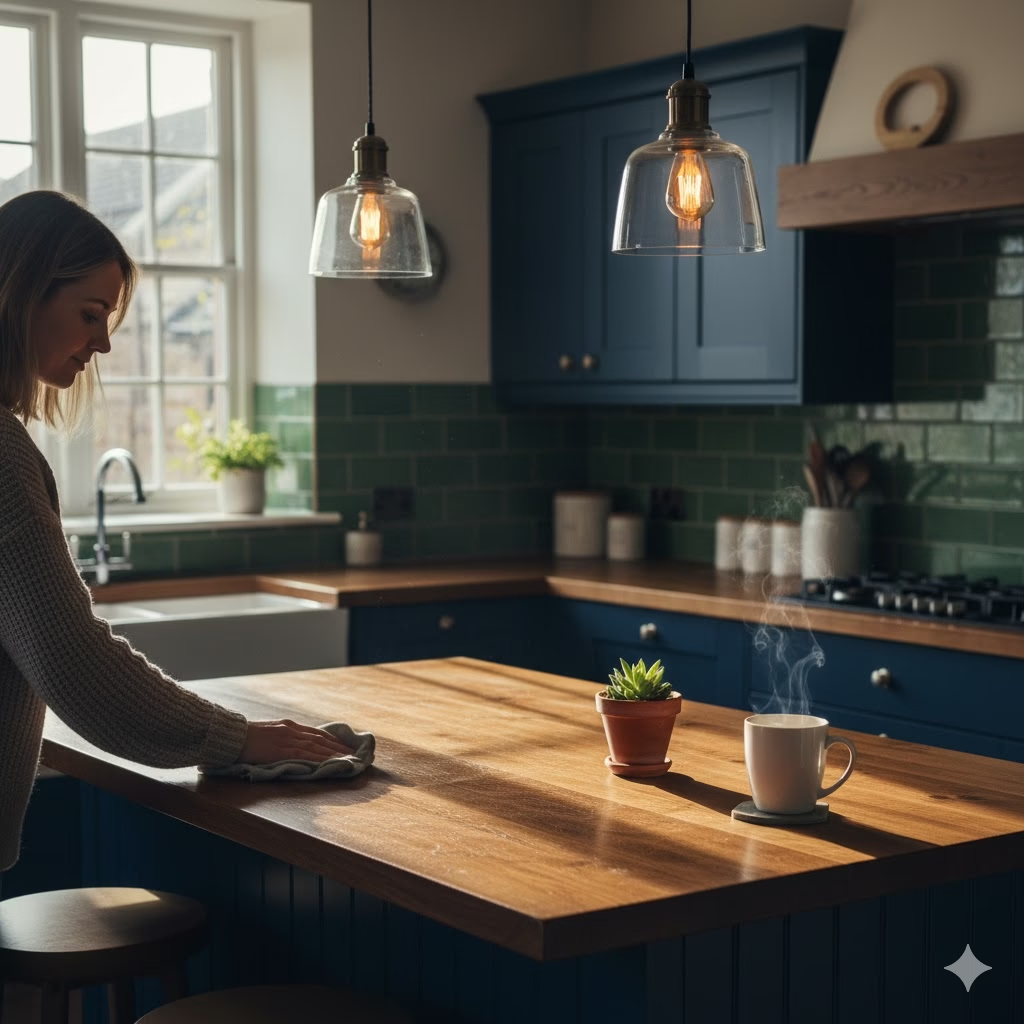
Once you have your wood, it is time to make your vision real.
- Measure Precisely: Accuracy is key for worktops. Get professional measurements if you are unsure.
- Consider Thickness: Reclaimed wood worktops often look best with a thicker profile (1.5 to 2.5 inches). This shows off their solidity.
- Edge Profiles: Decide on the edge style. A simple square edge, a soft chamfer, or a rounded bullnose can all work. A clean, natural edge often showcases the material best.
- Cut-outs: Plan for sink, faucet, and hob cut-outs. These need precise work. They are often best handled by experienced fabricators.
- Working with a Professional: Unless you have high-level woodworking skills and tools, let a professional woodworker or a specialized company fabricate your worktop. They have the knowledge to safely de-nail, mill, join planks (if required), and prepare the surface correctly.
Example:
I once saw a kitchen where the fabricator carefully kept an interesting knot in the reclaimed wood. They filled it with a clear resin. This created a subtle, stunning design feature. It proves how individual pieces can inspire unique touches.
Step 3: Finishing for Durability and Beauty
The finish protects the wood from moisture, stains, and daily wear. This is the stage where your reclaimed wood worktop changes from rough timber to a functional, stunning surface.
The finish you choose affects the look, feel, and maintenance of your worktop.
A. Oil Finishes (e.g., Tung Oil, Hardwax Oil):
- Pros: Penetrates the wood, boosting its natural grain and warmth. It is easy to repair scratches or damage by spot-treating the area. Offers a more natural, matte, or satin look.
- Cons: Needs more frequent reapplication (at least once or twice a year). It is less resistant to standing water if not maintained.
- How to Do It: Apply thin coats with a clean cloth. Rub the oil into the wood. Let it dry fully between coats. Buff off any extra oil. Use multiple coats for the best protection.
B. Polyurethane or Varnish Finishes:
- Pros: Forms a tough, protective film on the surface. It offers great resistance to water and stains. And is available in various sheens, from matte to high gloss. It needs less reapplication than oils.
- Cons: Can look less natural because it sits on top of the wood. It is hard to repair small areas. It often means sanding and refinishing the whole section.
- How to Do It: Apply evenly with a brush or roller in a dust-free area. Lightly sand between coats for better adhesion. Apply several coats for the best result.
C. Epoxy Resin Finishes:
- Pros: Creates a very tough, waterproof, and heat-resistant glass-like finish. Great for showing off unique wood features.
- Cons: Can look very modern, which may not suit all traditional reclaimed wood styles. Mixing and applying it must be precise. Repairs are difficult.
- How to Do It: Follow all manufacturer instructions for mixing. Pour carefully and spread evenly. Use a heat gun or torch to remove any bubbles. This is often a job for a professional.
Recommendation: For an authentic, luxurious feel with reclaimed wood, a high-quality hardwax oil is often best. It lets the wood breathe and is simple to refresh.
Step 4: Installation

While some adventurous people might install this themselves, professional installation is usually recommended. This is especially true for large or heavy worktops.
Key Installation Steps:
- Level Cabinets: Ensure your base cabinets are perfectly level. This prevents stress on the worktop and ensures a flat surface.
- Secure Fastening: Use the right fasteners to secure the worktop to the cabinets. This should allow for the slight seasonal movement of the wood.
- Sealing Edges (for sinks): If you have a sink cut-out, seal all raw edges thoroughly with a waterproof silicone sealant. Do this before the sink is dropped in. This prevents moisture damage.
Living with and Loving Your Reclaimed Wood Worktop: Maintenance
Good maintenance of your reclaimed wood worktop is vital. It preserves its beauty and durability for decades to come.
Daily Care Tips:
- Wipe Spills Immediately: Water is wood’s enemy. Do not let spills sit, especially acidic liquids like lemon juice or wine, which can damage the finish.
- Use Mild Cleaners: A damp cloth with a little dish soap works well. Avoid harsh cleaners, abrasive scrubbers, or steam cleaners. These can strip the finish.
- Use Cutting Boards and Trivets: Always use a cutting board for chopping. Always use trivets for hot pans. While wood is tough, you must protect your surface from direct cuts or scorch marks.
- Avoid Standing Water: Especially near sinks and taps. Wipe these areas dry after every use.
Periodic Maintenance:
- Re-oiling (for oil finishes): Depending on how much you use it, re-oil your worktop every 6 to 12 months. Do this when the wood looks dry or easily absorbs water. This is a simple process: clean the surface, sand lightly if needed, and apply a thin coat of the oil.
- Inspecting for Damage: Check often for any deep scratches or areas where the finish looks weak. Fix these immediately to prevent worse damage.
- Addressing Scratches (Oil Finishes): Light scratches on oiled surfaces can be gently sanded out. Then, re-oil the area to blend it in. Deeper scratches will need more work.
Long-Term Considerations:
- Humidity Control: Wood reacts to changes in humidity. Keep a consistent indoor humidity level (ideally 40–50%). This helps to minimize wood movement.
- Embrace Patina: Your reclaimed wood worktop will naturally develop its own patina over time. This adds to its charm and should be seen as a sign of life, not a flaw.
Styling Your Reclaimed Wood Worktop

The great thing about reclaimed wood is its flexibility. It can fit with almost any kitchen style.
- Modern Farmhouse: Pair it with Shaker-style cabinets, subway tiles, and open shelving. The wood adds warmth to crisp white colours.
- Industrial Chic: Mix the raw texture of reclaimed wood with black metal accents, exposed brick, and stainless steel appliances. The contrast is powerful.
- Minimalist Nordic: Let the wood be the main feature. Keep other items simple and clean. Light colours and natural textures let the wood’s character shine.
- Eclectic Bohemian: Mix different textures, patterns, and colours. Reclaimed wood keeps the space grounded. It brings an authentic, earthy feel to a vibrant room.
Final Thoughts: The Enduring Appeal of Reclaimed Wood
Choosing a reclaimed wood worktop is more than a design choice. It is a powerful statement. That shows your commitment to sustainability, your appreciation for history, and your love for real beauty. It is a focal point that will start conversations, collect memories, and age gracefully with your family.
If you want to fill your kitchen with soul, character, and a touch of eco-conscious grandeur, embrace the allure of reclaimed wood. It is truly the new luxury. Your kitchen deserves a surface with a story to tell.
Frequently Asked Questions (FAQ)
Q: Is reclaimed wood more expensive than new wood?
A: Not always. The cost depends a lot on the wood species, its rarity, and the process of preparing it. It may cost more due to the work involved in salvaging and preparing it. However, it offers unique style and sustainability benefits that new wood cannot match.
Q: Can reclaimed wood be used in bathrooms or other wet areas?
A: Yes, with the right sealing and maintenance, just like any wood. However, you must be extra careful to wipe away standing water right away. A very waterproof finish, like marine-grade varnish or epoxy, might be a good choice for very wet spots.
Q: Will reclaimed wood warp or crack?
A: Good suppliers make sure the wood has been properly dried (kiln-dried) to control its moisture level. This makes it less likely to warp and crack than newly milled wood. However, all wood can react to big changes in humidity. Keep consistent indoor conditions to minimize movement.
Q: How do I clean a reclaimed wood worktop?
A: Use a damp cloth with a mild dish soap solution for daily cleaning. Do not use harsh chemical cleaners, abrasive pads, or steam cleaners. These can damage the finish or the wood itself.
Q: Can I cut directly on a reclaimed wood worktop?
A: Wood is resilient, but you should always use a cutting board. This protects your worktop from knife marks. It also helps keep its finish and lengthens its life.
References
- kaltimber – Is Reclaimed Wood More Sustainable? Benefits & Why It’s
- Stikwood – What is Reclaimed Wood? Discover Its Benefits and Charm
- Sustainabilitytracker – The benefits of reclaimed wood
Recent Posts

